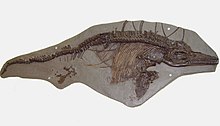
Ichthyosauria is an order of large extinct marine reptiles sometimes referred to as "ichthyosaurs," although the term is also used for wider clades that the order resides in.
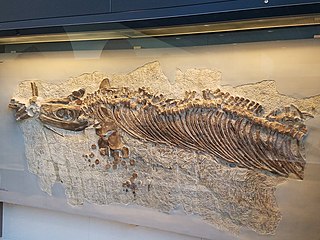
Cymbospondylus is an extinct genus of large ichthyosaurs, of which it is among the oldest representatives, that lived during the Anisian stage of the Middle Triassic in what are now North America and Europe. The first known fossils of this taxon are a set of more or less complete vertebrae which were discovered in the 19th century in various mountain ranges of Nevada, in the United States, before being named and described by Joseph Leidy in 1868. It is in the beginning of the 20th century that more complete fossils were discovered through several expeditions launched by the University of California, and described in more detail by John Campbell Merriam in 1908, thus visualizing the overall anatomy of the animal. While many species have been assigned to the genus, only five are recognized as valid, the others being considered synonymous, doubtful or belonging to other genera. Cymbospondylus was formerly classified as a representative of the Shastasauridae, but more recent studies consider it to be more basal, view as the type genus of the Cymbospondylidae.
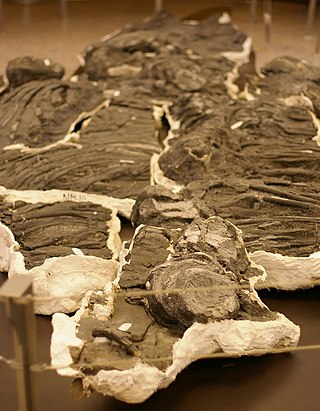
Shastasauridae is an extinct family of Triassic ichthyosaurs that includes the genera Shastasaurus, Shonisaurus and Himalayasaurus. Many other Triassic ichthyosaurs have been assigned to Shastasauridae in the past, but recent phylogenetic analyses suggest that these species form an evolutionary grade of early ichthyosaurs rather than a true clade or evolutionary grouping that can be called Shastasauridae.
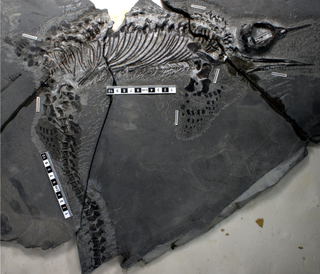
Chaohusaurus is an extinct genus of basal ichthyopterygian, depending on definition possibly ichthyosaur, from the Early Triassic of Chaohu and Yuanan, China.

Contectopalatus was a primitive ichthyosaur, an extinct fish-like marine reptile from the Middle Triassic of Germany and China. It was originally named Ichthyosaurus atavus by Quenstedt in 1852, and later reassigned to Mixosaurus. It was recognised as a separate genus by Maisch and Matzke in 1998, though other researchers have classified it as a species of Phalarodon instead.

Ophthalmosauridae is an extinct family of thunnosaur ichthyosaurs from the Middle Jurassic to the early Late Cretaceous worldwide. Almost all ichthyosaurs from the Middle Jurassic onwards belong to the family, until the extinction of ichthyosaurs in the early Late Cretaceous. Opthalmosaurids appeared worldwide during early Bajocian, subsequent to the disappearance of most other ichthyosaur lineages after the end of the Toarcian. Currently, the oldest known ophthalmosaurids is Mollesaurus from the early Bajocian of Argentina, as well as indeterminate remains of the same age from Luxembourg and Canada. Named by George H. Baur, in 1887, the family contains the basal taxa like Ophthalmosaurus. Appleby (1956) named the taxon Ophthalmosauria which was followed by some authors, but these two names are often treated as synonyms; Ophthalmosauridae has the priority over Ophthalmosauria. However, some researchers argue that Ophthalmosauridae should be restricted to the group typically referred to as Ophthalmosaurinae, with classic Platypterygiinae instead being referred to as Undorosauridae or Brachypterygiidae and Ophthalmosauria being used to unite these two groups.

Undorosaurus is an extinct genus of ophthalmosaurid ichthyosaur known from western Russia, Svalbard, and Poland. It was a large ichthyosaur, with the type species measuring 4–6 metres (13–20 ft) long.

Hudsonelpidia is an extinct genus of small parvipelvian ichthyosaur known from British Columbia of Canada.
Parvinatator, from Latin, “parvus” little and “natator” swimmer, is an extinct genus of small ichthyopterygian marine reptile that lived during the Early to Middle Triassic. Its fossils have been found in British Columbia, Canada.

Thaisaurus is an extinct genus of ichthyopterygian marine reptile that lived during the Spathian. Fossils have been found in Thailand.
Wimanius is a genus of ichthyosaur from the Middle Triassic of Switzerland, containing a single species, Wimanius odontopalatus. It was described by Michael Maisch and Andreas Matzke in 1998 based on an incomplete skull from Monte San Giorgio, a mountain on the Swiss-Italian border. Wimanius possesses teeth on its palate, though whether they were located on the palatine or pterygoid is disputed. Other features of Wimanius include a large orbit and jugals with two rami of similar lengths. Different phylogenetic placements of Wimanius have been recovered by different studies, including it being a mixosaurid relative or a merriamosaur, and a monotypic family, Wimaniidae has been named for it. However, its validity has also been questioned, and synonymy with various other genera has been proposed.
Mixosauridae was an early group of ichthyosaurs, living between 247.2 and 235 million years ago, during the Triassic period. Fossils of mixosaurs have been found all over the world: China, Timor, Indonesia, Italy, Germany, Spitsbergen, Switzerland, Svalbard, Canada, Alaska, and Nevada.

Cymbospondylidae is an extinct family of Hueneosaurian Ichthyosaurs known from the Middle Triassic of Europe, North America, and Asia.

Thunnosauria is an extinct clade of parvipelvian ichthyosaurs from the Early Jurassic to the early Late Cretaceous (Hettangian–Cenomanian) of Asia, Australia, Europe, North America, and South America. Named by Ryosuke Motani in 1999, it contains the basal taxa Ichthyosaurus and Stenopterygius and the family Ophthalmosauridae. In thunnosaurs, the fore fin is at least twice as long as the hind fin.

Macgowania is an extinct genus of parvipelvian ichthyosaur known from British Columbia of Canada.
The Hueneosauria are a group of Ichthyosauria, living during the Mesozoic.

Merriamosauria is an extinct clade of ichthyosaurs. It was named by Ryosuke Motani in his 1999 analysis of the relationships of ichthyopterygian marine reptiles and was defined in phylogenetic terms as a stem-based taxon including "the last common ancestor of Shastasaurus pacificus and Ichthyosaurus communis, and all of its descendants." The name honours John Campbell Merriam. Based on this definition, Merriamosauria includes most ichthyosaurs except for several Triassic groups such as the clade Mixosauria, the family Cymbospondylidae, and perhaps the family Toretocnemidae. Merriamosaurs are characterized by features in their pectoral girdles and limb bones, including an extensive connection between the scapula and the coracoid bone, the absence of the first metacarpal and the absence of a pisiform bone.
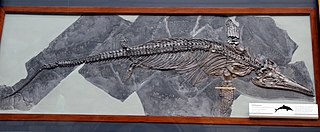
The Ichthyosauromorpha are an extinct clade of marine reptiles consisting of the Ichthyosauriformes and the Hupehsuchia, living during the Mesozoic.
